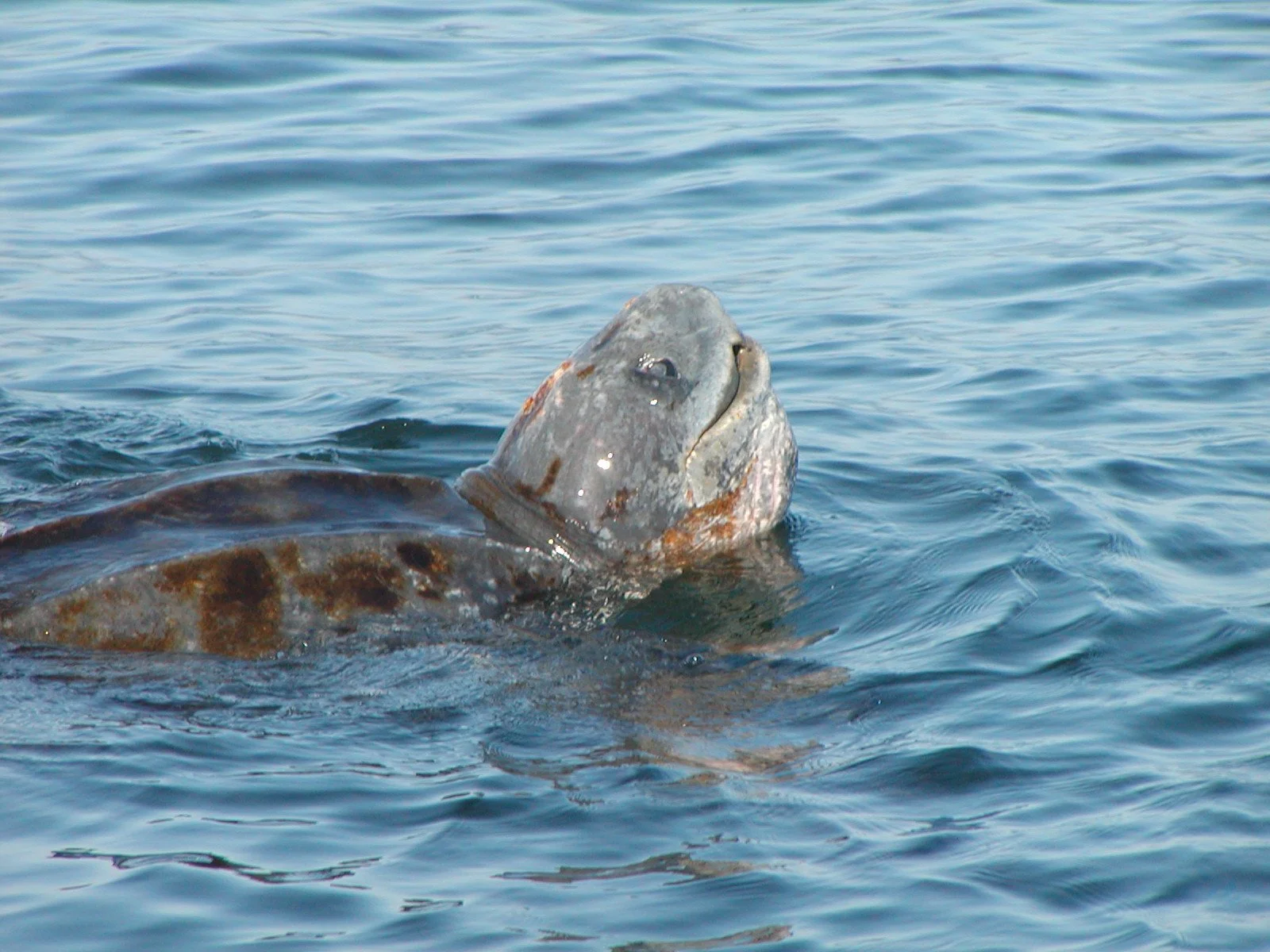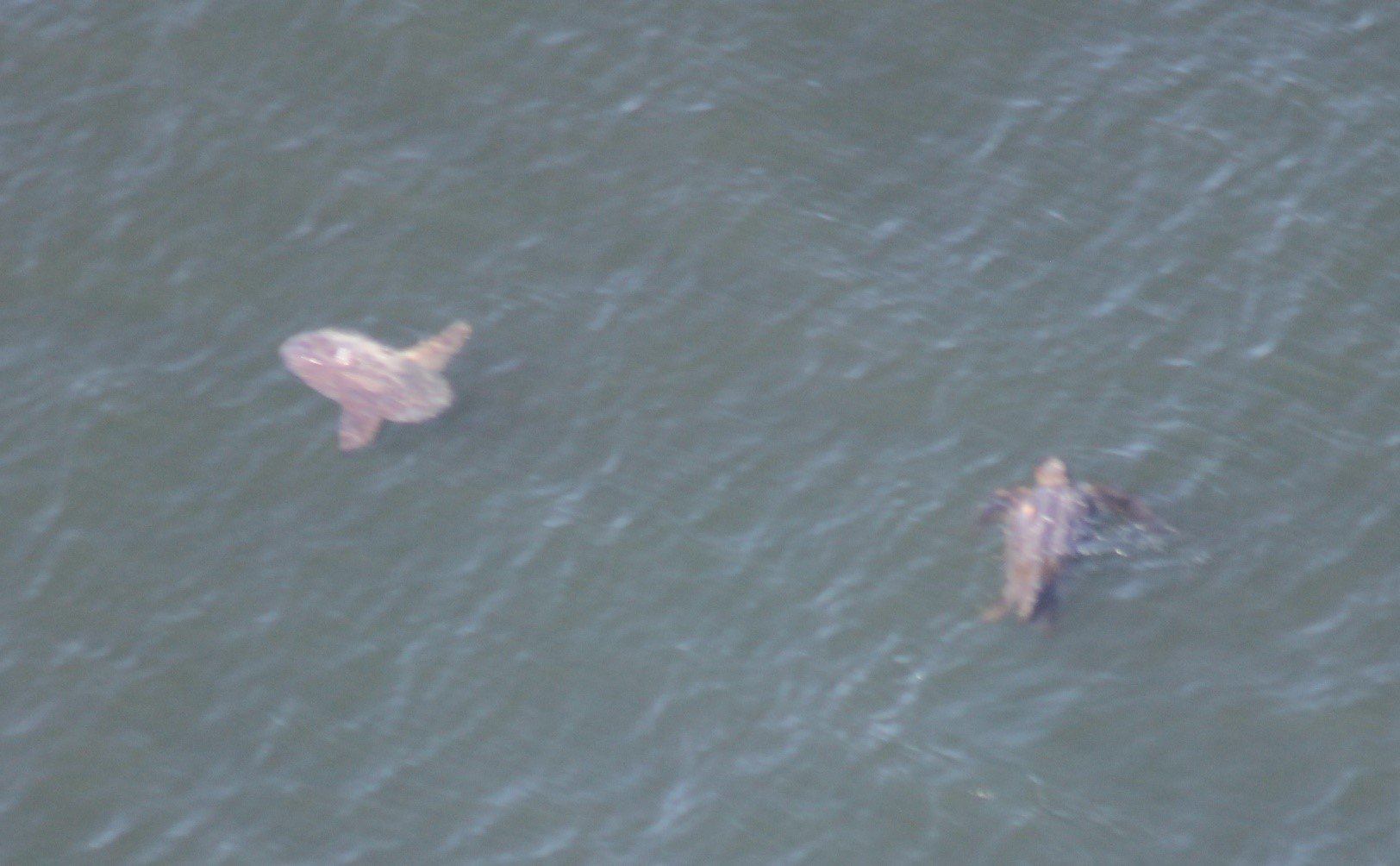Upwell and NOAA conduct yearly monitoring of West Pacific leatherbacks that come to feed on gelatinous zooplankton (jellyfish) blooms in the California Current. Turtles equipped with satellite tags in the California Current have displayed trans-Pacific migrations back to nesting beaches in Indonesia, Papua New Guinea and the Solomon Islands. Although West Pacific leatherbacks are hatched on these nesting beaches, not all of them migrate to the US West Coast to forage.
The West Pacific leatherback population has distinct subpopulations that nest during different seasons and migrate to foraging grounds throughout the Pacific Ocean. Turtles nesting from June to August (boreal summer nesters, tracks in red and green below) travel to foraging habitats in the South China Sea, North Pacific Transition Zone and US West Coast during post-nesting periods. Turtles nesting from November to January (boreal winter nesters, tracks in blue) forage off Australia, New Zealand and Indonesia.
Unfortunately, the entire West Pacific population is in danger of extinction with an estimated 1,500-2,000 adult turtles remaining. Creating cohesive protections for them is difficult because of their epic migrations from nesting to foraging areas. Mating and nesting require a lot of energy, so when the season is over, turtles migrate to search for gelatinous zooplankton aggregations to bulk up again. The highly productive subtropical convergence zone and oceanic eddies off New Zealand’s North Island support these aggregations, and this region has become a focus of attention for leatherback conservation and bycatch prevention.
A New Zealand Department of Conservation (DOC) led project by Dr. Matt Dunn of the National Institute of Water and Atmospheric Research (NIWA) and colleagues found a significant increase in reported interactions of turtles with New Zealand’s surface longline fisheries during the 2020/21 fishing season. Nearly all bycaught leatherbacks were alive when released, but little is known about their post-release survival. The figure to the right (Dunn et al. 2023), shows the distribution of leatherback turtle captures (red dots) reported by fishers and observers on fishing boats between 2007 and 2021. There were 217 captures total, including 50 in the 2020/21 fishing season alone.
In New Zealand, all sea turtles are protected species. However, setting and achieving conservation goals for leatherbacks in New Zealand’s coastal waters is difficult because little is known about leatherback abundance and distribution there. To collect this critical data, Upwell teamed up with NIWA and Monash University (Australia) to submit a proposal to the New Zealand Department Of Conservation (DOC) to conduct aerial surveys for leatherbacks in the Bay of Plenty off the North Island. The proposal was accepted, and the surveys will be carried out during the austral summer (February and March) of 2025. As in California, Upwell and our partners at NOAA will collaborate to conduct the surveys in New Zealand according to our established methodology, described below.
During an aerial survey, observers search from a plane’s windows (ideally floor or bubble windows) as the plane flies in transects (evenly spaced straight lines) at 200 meters (around 600 feet) above the ocean’s surface.
Observers call out the wildlife they see to a data recorder who logs sightings into a laptop computer connected to a Global Positioning System (GPS), creating a map. An example of one of these maps from surveys by NOAA and Upwell in California shows proxy species (large molas) and prey species (sea jelly aggregations) in addition to leatherbacks. These surveys also benefit species of whales, dolphins and hard-shelled turtles, since their presence is also documented.
Photo by Karin Forney and Scott Benson, Courtesy of NOAA Fisheries.
These surveys will generate data and maps that will help us answer questions about how leatherbacks use foraging habitat in New Zealand waters. This information can help New Zealand’s efforts to protect leatherbacks and reduce bycatch in commercial fisheries.
Protecting leatherbacks requires conservation methods that match their highly migratory nature. Every country that protects leatherbacks within its EEZ helps maintain and recover the Western Pacific population as they migrate from nesting beaches to foraging habitats, and back again.
Acknowledgements:
This project is being administered through the New Zealand DOC Conservations Services Programme with 50/50 crown/industry funding. The project conception is attributed to Clinton Duffy (formerly DOC, now Auckland Museum). We thank DOC contract manager Dr. Karen Middlemiss (Science Adviser, Bycatch and Treats Team), aircraft providers at Union Airways, Island Aviation, Sunair and representatives of Pelco Fishing for input. We are also grateful to be in contact via DOC and NIWA with representatives of Iwi around the survey area. We thank all those who have provided us with feedback and guidance on the project so far.






